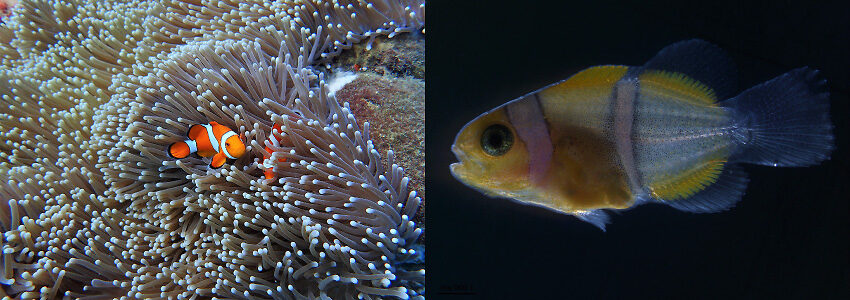Marine Eco-Evo-Devo Unit (Vincent Laudet)
The marine Eco-Evo-Devo unit uses the extraordinary diversity of coral reef fish to better understand the role of hormones in the evolution of life history strategies, in a perspective integrating ecological, evolutionary and developmental components. Most coral reef fish exhibit a biphasic life cycle with a pelagic larvae that ultimately transforms into a reef associated juvenile. A very convenient aspect of this life cycle is that for many species it is possible to capture larvae when they enter the reef by placing a net at reef crest: using such nets we have access to fish larvae that are naturally synchronized with respect to their metamorphosis. Interestingly however, the numerous species of coral reef fish vary according to the timing, duration and magnitude of their metamorphosis. Some pelagic species even bypass this step by developing directly into juveniles. We have previously demonstrated that thyroid hormones (TH) control one of the most salient features of metamorphosis: the development of the extraordinarily variable pigmentation pattern of the reef-associated fish. Strikingly, the effect of TH on this pattern is variable since in some species such as the clownfish (Amphiprion ocellaris) the pigmentation is under TH control whereas in other such as Acanthurus triostegus, a surgeonfish, it is not.
We therefore have a vast array of peculiar adaptations, innovations, and constrains to explore. Although many Evo/Devo studies have scrutinized the emergence of animal adaptations, this has rarely been done taking into account the environmental parameters and in particular the role of hormones in the plasticity of the traits. Coral fish offer us, thanks to their diversity, an excellent ground to study how hormonal signals can intervene in evolutionary innovations. We therefore wonder how the environment shapes developmental trajectories and how changes in hormonal systems can explain the diversity of life history strategies observed in coral reef fish.
Therefore, we use two coral reef species: A. triostegus, as an ecophysiological model and the clownfish A. ocellaris as an experimental model in which functional approaches can be developed. The unit addresses three main questions:
- How do fish larvae integrate environmental and physiological information to trigger coordinated programs leading to metamorphosis?
- How do differences in hormone signaling explain the diversity of patterns of pigmentation produced during metamorphosis?
- How do anthropogenic stressors linked with global environmental changes affect these processes?




